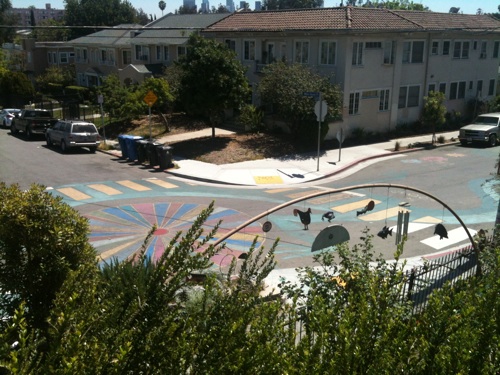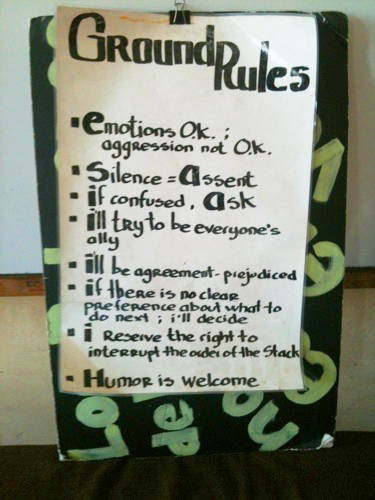Sustainabilities: Eco-oriented | Utopian
The Los Angeles Eco-Village (LAEV) came into being as a response to community crisis. On April 29, 1992, an outpouring of pain ravaged many southern and central L.A. neighborhoods and businesses. This violence, what many in the city choose to call the Civil Unrest rather than the L.A. riots, followed a court's decision to ignore the injustice of state-sponsored violence against a Black man's body.1 After the fires were out, many residents strategized about how to address the dynamics that had led to the riotous conflagration.
One group of people who had been planning to build a new eco-community on the outskirts of LA reconsidered and decided to locate their utopian project in a central neighborhood. A key figure in the group was Lois Arkin, who in 1980 had founded the Cooperative Resources Services Project (CRSP) as a booster for cooperative living arrangements. After the civil unrest, the organizers of the fledgling eco project focused on her block near 1st Street and Vermont Avenue.2 Lois is a charismatic white woman who had been steeped in eco-culture during her years living in Berkeley. She used word of mouth and ads in local papers to recruit people for something the ads described as similar to an artists’ community. Technically, it was to be an “intentional community,” a term that can refer to a variety of shared living situations where “people live together on the basis of explicit common values.” An important feature of this particular iteration would be its focus on fostering a sustainable community. When I started my ethnographic engagement with LAEV in 2008, I found that “sustainable community” here meant more than reducing negative environmental impacts onsite; it also meant striving toward a collectivity of individual activists whose efforts impacted the city beyond.
In 1993, CRSP's fundraising led to the purchase of a 40-unit building at 117 Bimini Place, at the intersection of Wilshire Center, Koreatown, and East Hollywood. Most of the units were studio apartments, and they became LAEV's first cohousing.3 Located a block off of a congested arterial, Vermont Avenue, on a quiet two-block street, the 1920s building had many units in disrepair when purchased. Some were filled with garbage and broken appliances. The eco-villagers did not evict the few existing residents, instead incorporating them into the intentional community as “long-term renters.” By the time I showed up, most units had been rehabilitated. A few long-term renters still live in the building today, some keeping to themselves and some tied to the intentional community in various ways. Over the years, the other units filled up with artists and activists who cycled through as permanent members or temporary residents. The community worked to develop a membership process and standards for facilitating and participating in consensus-based decision-making. This focus on process resulted from years of trial by fire, as the project's experimental nature sometimes attracted people whose own personal issues and unstable mental health made cooperation difficult.

Intersection repair in front of LAEV
Every month or so, Lois or another eco-villager leads a tour of the buildings, followed by a question-and-answer session. My initial tour took place on a Saturday morning in June 2008. On the street in front of 117, faded designs covered the pavement. I knew from my time living in Portland, Oregon that this was called “intersection repair”—decorating intersections with designs that call attention to their role as public spaces.4 Inside the lobby sat large velvet couches, invitingly low and wide. Outside, trees, gardens, and a sprawling chicken house filled the space between the building’s wings. At the center of the courtyard, a magnolia tree spread its branches, creating a shady area, and here sat a number of chairs around a makeshift table made of a jagged granite slab on a wooden frame. Upstairs, the building’s largest unit had been converted into a community room. On the tour, Lois explained the goal of the eco-village: to create a human-scaled, full-featured demonstration community that integrated social, economic, and ecological systems and created no waste. Usually eco-villages were in rural settings, and were built new. This retrofitted, urban eco-village was very unique, both in its siting and the subsequent diversity of its members. A DIY ethic was evident throughout the space.
I decided to become a member, and found that the membership process hinged on something that usually gets overlooked when considering a move. Interested individuals had prove they weren't simply attracted to the aesthetic or vibe of the place. The process started with a questionnaire stating that “LAEV is located in an ‘inner city’ environment: densely urban, ethnically diverse, and primarily working class.” This seemed to select for people who were committed not just to ecological sustainability, but also to various forms of diversity. Lois kept track of member demographics, but this was a somewhat controversial practice. In retrospect, I've found that some in the community took racial diversity for granted, probably because it is a regular feature of Los Angeles. Community members had a keen sense of the individual nature of the membership process, and perhaps direct attention to diversity felt out of step with this. Regardless, LAEV was notable for addressing the topic; most eco-villages leave questions of race and racism aside, as is common in “ecotopian” projects.5 Talking to community members in April 2015, I heard that there still isn't a consensus on the extent to which racial and other forms of diversity should influence membership decisions, or even on what “diversity” means.
More settled is the expectation that members, whoever they are, will participate in community life. Eco-villagers are engaged in various ways with top-down advocacy and bottom-up activism in the city, but LAEV is a multicultural hub for everyday "green" practices more than it's designed to foster sustainability on a large scale. The example most central to my own work is transportation. While Los Angeles is known as a city where driving is the best way to get around, LAEV functioned as an important node in a social network that supported the growth of bicycling there, as I have chronicled elsewhere.6 Many eco-villagers chose to live “carfree,” some as a rejection of the violence justified by oil dependence, some because they enjoyed the challenge of getting around LA on bikes and buses, and others because they planned to be ready for a time of “peak oil” that would require alternative fuel sources. Close to both express and local buses running 24 hours a day on Vermont Avenue and the Vermont/Beverly subway station that opened in 1999, LAEV was strategically sited to enable living in LA without a car. Seafood City, a Filipino grocery store, was just down an alley; a Vons supermarket sat two blocks down the street; and Jon’s, a Latino market, was about a five-block walk from the building. A food cooperative had been set up in the lobby of the main building, bringing produce and dry goods to the site. Members and residents who did not own cars even got a discount on rent. LAEV showed me that existing alternative mobility practices play a role in building collective action around sustainable transportation. I often find this link missing in the future-oriented approach common in advocacy.
The emphasis on belonging through how you lived today started with the membership process, which included two interviews where the prospective member would sit at the front of a meeting and answer questions. One member always made a point of challenging prospective members with aggressive questions: “You do know that we don’t have parking, right?” “I mean, you’ve seen the building. This ain’t Santa Monica.” These questions broadcast that here, “eco” did not come easy. We could be a tough bunch, verging on cliquish. Early in my membership process, a Hollywood starlet’s manager contacted Lois about having her move in at LAEV because of her interest in ecology. The community decided that she could not bypass the membership process, and her people did not call again. During one of my last meetings at LAEV, I saw the community hesitate to welcome a potential member because she did not yet ride her bike to work. There can be an exclusivity to these communities, which seems at odds with the ostensibly democratic project of sustainability. And sometimes community members protected each other from criticism, even when individual actions made others feel unwelcome. Rules were flexible, as ethnographers often find. On my most recent visit to the community, I learned that this tension between fixed policies and case-by-case flexing of the rules is coming into the spotlight more as a topic for group discussion.

The LAEV community rules in 2013
Because of its inward focus, LAEV's impact is in some ways traceable only through the people who have participated in the project, and recently I have noticed its influence on me. I moved away from Los Angeles in 2011, though I've visited LAEV almost every time I've been back in town. I see it now as an important site where a racially integrated group experiments with life beyond the usual story for many of us who grew up in marginalized communities: rising above poverty, we are expected to embrace status-oriented consumerism. I worry, though, that those embedded in the community do not recognize this as a central feature of the place. It may be something I value because of my experiences as a Chicana working in sustainable transportation, a DIY activist in a field that has adopted an aspirational theory of change enacted through neoliberal urbanism. Incidentally, my time in which I could return to LAEV as a member has just run out. If I want to move back, will I go through the process again? Or will I ask them to bend the rules, just this once?
– Adonia Lugo
Published June 1, 2015
1. Robert Gottlieb, Mark Vallianatos, Regina M. Freer, and Peter Dreier, The Next Los Angeles: The Struggle for a Livable City, (Berkeley: University of California Press, 2005).
2. Details from author’s personal communication with Lois Arkin, April 10, 2013.
3. Members and residents at LAEV occupy their own living spaces. CRSP acquired a fourplex next door to the original building in the 2000s, expanding the available housing options. Most events are held in common areas.
4. This model was created by the City Repair Project based in Portland, OR. LAEV has hosted City Repair figures as speakers and as facilitators of intersection repair projects on several occasions.
5. Ellen Stroud, “Troubled Waters in Ecotopia: Environmental Racism in Portland, Oregon,” Radical History Review, 74 (1999), 65–95.
6. Adonia E. Lugo, “How Critical Mass Built the LA Bike Movement,” in Shift Happens! Critical Mass at 20, Chris Carlsson, LisaRuth Elliott, and Adriana Camarena, eds., (San Francisco: Full Enjoyment Books, 2012).
Visit Sites
- 16th & Mission
- Bateson State Office Building
- Bayview-Hunters Point
- Beach Flats Community Garden
- Cesar Chavez Street
- CicLAvia
- Ecotopia
- Fruitvale Transit Village
- Gonzales
- Googleplex
- Haight Ashbury Recycling Center
- Integral Urban House
- La Mesa Verde, San Jose
- Los Angeles Eco-Village
- Mandela MarketPlace
- North Berkeley Farmers’ Market
- Oakland Ecopolis
- Pajaro Valley Watershed
- Treasure Island
- West Oakland

